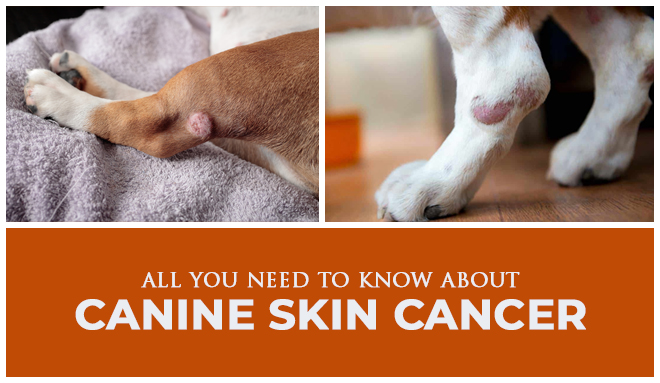Just like humans, dogs, too, can get cancer. Though there are many types of cancers seen in canines, but majorly, skin cancer is one of the most frequently spotted cancers in dogs. One possible reason could be, compared to internal organs, the skin is always exposed to tumor-causing external factors such as radiation and chemicals.

The good thing is skin cancers are easier to detect as any lump that develops on your dog’s skin is effortlessly seen with naked eyes. And as a result, it gets reported to a vet soon enough, preventing it from advancing, causing minimal damage to canine health.
Indisputably, every dog parent loves their canine companions, and developing an understanding of this skin malignancy adds to the way you care for your animal companion.
This blog provides you with all you need to know about the types of skin malignancies dogs suffer from, their common symptoms, and possible line of treatments. Read the article to know more:
Types of Canine Skin Cancer
Dogs suffer from different types of skin cancers, out of which, Mast Cell Tumors, Squamous Cell Carcinoma, and Malignant Melanoma are some of the frequently detected skin malignancies in dogs.
Mast Cell Tumors
Mast Cell tumors are named after the type of cells they develop in. Mostly, this tumor grows in the mast cells of a dog’s immune system. Mast cell tumors are the most common malignant tumors detected in dogs. This type of cancer is seen in dogs of any age, but is often found in canines between the 8-10 year age groups.
Mast Cell tumors can grow in any part of a dog’s body both internally and externally; however, the chest, lower abdomen and back of their upper thigh are the favored sites. The tumor appears as a soft or solid erupted mass that differs in size.
Pugs, Boxers, Boston Terriers and Rhodesian Ridgeback dog breeds are prone to this illness.
Squamous Cell Carcinoma
Squamous cell carcinoma is the most commonly seen skin cancer in dogs that mostly affects older dogs. The tumor develops in two forms; skin and sublingual.
Skin tumors appear as firm, erupted, wart-like lumps, frequently seen on a dog’s lower legs, on their head and abdomen. Sublingual tumors are usually irregular masses with pimples or ulcers that develop under dog’s claw.
Some Squamous cell tumors develop due to extended sun exposure; however, papillomavirus can also be associated with this type of malignancy.
Squamous cell carcinoma is commonly seen in Beagles, Dalmatians, Scottish Terriers, White Bull Terriers, and Standard Poodles.
Malignant Melanoma
Malignant Melanoma effects pigmented cells (melanocytes). They grow exceedingly fast and often get spread to other body parts including vital organs like the lungs and liver.
Majority of malignant tumors grow in the mucous membranes or in your dog’s mouth. However, some tumors are seen on the hairy parts of your dog’s body.
There is no known reason that encourages the development of malignant melanomas; however, genetics can be a factor in this regard. Persistent licking of a certain body part along with trauma can aid in cell multiplication resulting in cell mutation.
Comparatively, male dogs are at a higher risk of developing malignant melanomas than female canines. And as far as dog breeds are concerned, Scottish Terriers and Schnauzers are prone to this type of skin malignancy.
Signs
Dogs suffering from skin cancer show a variety of symptoms. These signs vary depending upon the dog breed and type of cancer. Look for the signs mentioned below for any malignancy that may be developing in your dog:
- Mast cell tumor: Soft, inflamed raised mass that differs in size
- Squamous cell carcinomas: Solid, erupted, wart-like lumps
- Malignant Melanomas: Colored lumps in mouth, lips, and feet
Diagnosis
Your canine needs to go through a fine needle aspiration to examine a tiny part of the tumor cell to perform a biopsy. This procedure can provide an accurate diagnosis of the malignancy and your dog’s current condition.
Treatment
Skin cancer detected at an early stage can be treated effectively and over a period of time, dogs often recover completely from the illness.
Treatment of skin cancer varies depending on the type of malignancy and the location of the tumor.
Depending upon how much the disease has spread, skin cancer in dogs can be treated with surgery, chemotherapy, radiation, or other relative therapy and appropriate medicines.
In the End
Undoubtedly, the word ‘cancer’ strikes fear. But the solution to any fear lies on the other side of it. So, instead of living in distress, be watchful, lookout for the signs mentioned earlier in the blog, and check your dog’s skin and coat more often; all of these exercises can help you spot any tumor that might be developing on your dog’s skin at an early stage. Plus, frequent vet visits aid in catching any skin anomalies which you are not able to recognize with naked eyes before it become a serious concern.

